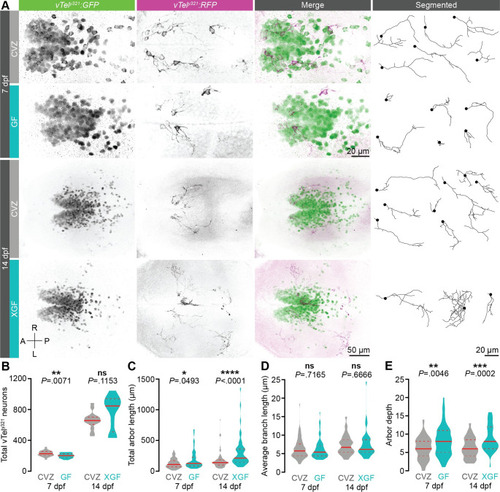Fig 2
- ID
- ZDB-FIG-221105-10
- Publication
- Bruckner et al., 2022 - The microbiota promotes social behavior by modulating microglial remodeling of forebrain neurons
- Other Figures
- All Figure Page
- Back to All Figure Page
|
The microbiota restrains vTely321 arborization.
(A) Maximum-intensity projections of vTely321 GFP (green), sparse mosaic vTely321 RFP (magenta), and individually segmented vTely321 neurons from the same representative 7 dpf (top) or 14 dpf (bottom) larvae raised CVZ (gray), GF (aqua), or XGF (aqua). (B) The total number of vTely321 GFP neurons is reduced in 7 dpf GF larvae relative to CVZ controls (n = 24 CVZ and 22 GF larvae; unpaired t test), but not in 14 dpf XGF larvae relative to CVZ controls (n = 14 CVZ and 12 XGF larvae; Mann–Whitney U test). (C-E) Total arbor length (C) and arbor depth (E) are increased and average branch length is unchanged (D) in 7 dpf GF larvae relative to CVZ controls (n = 73 neurons from 24 CVZ larvae and 69 neurons from 25 GF larvae; Mann–Whitney U tests) and in 14 dpf XGF larvae relative to CVZ controls (n = 69 neurons from 14 CVZ larvae and 46 neurons from 13 XGF larvae; Mann–Whitney U tests). ns, not significant; *, P < .05; **, P < .01; ***, P < .001; ****, P < .0001. Solid red line represents the median; dotted red lines represent the upper and lower quartiles. Data underlying this figure are available on figshare: https://figshare.com/projects/Bruckner_et_al_Data/136756. |

